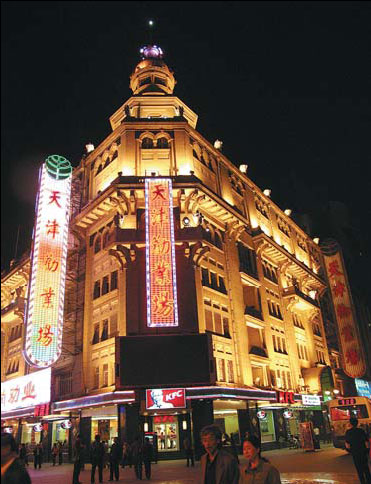Tianjin opens its arms to the world
|
Tianjin Quanyechang Shopping Mall is in the former French Concession. Liu Zhaoming / For China Daily |
Just a short train ride from Beijing lies the city of Tianjin, facing onto the Bohai Sea.
With the Haihe River running through it, Tianjin is an important Chinese city that was established in the Ming Dynasty (1368-1644) and served as an imperial port - with foreign concessions.
The growth of Tianjin's foreign concessions began after the Second Opium War (1856-1860).
The Treaty of Tientsin, signed in the city in 1858 and ratified by the Chinese emperor in 1860, opened the port up to foreign traders who built villas in nine concessions for Italy, Germany, France, Russia, Britain, Austria-Hungary, Japan, America and Belgium.
Neighboring each other along the banks of the Haihe River, the architecture of these concessions were very different to the rest of the city, with a blend of Western and Chinese styles.
The concessions contained both homes and offices for a group of traders, company owners, government officials, the military and even celebrities. And although the concession days have long gone, about 1,000 buildings from that era remain.
Once regarded as something of a humiliation for the country and left to fall into disrepair, today Tianjin has embraced the buildings as a unique attraction of the city, and they have been renovated to attract tourists.
Five-Avenue District: The best-known part of Tianjin's concession area, Five-Avenue contains more than 400 villas, in various European architectural styles. The development of the concession began with Racecourse Road, so named because of a British horseracing club in the area.
From 1919 to 1926 new streets were added to the district and named after British cities. Although the local government renamed most of them after the names of Chinese cities during the 1960s, Racecourse Road retained its original name. 
The district was home to many important historical figures and a number of political refugees who moved here after resigning from office in Beijing. Among the foreign residents were the US' 31st president Herbert Hoover, British world champion athlete Eric Liddell and French scientist Emile Licent.
Former British Concession: The area, situated on the right bank of the Haihe River, was the trade center of the city. Known as North Jiefang Road Financial Street, it was once nicknamed the "Wall Street of the East". Along the street are over 10 revamped European buildings that are more than 100 years old.
Little White House and Central Park: Initially a de-facto US concession that was later given over to the British, this area was once home to a US military camp. With strict restrictions on commercial activity in the neighboring British concession, the area became a business center and Central Park, which sits within it.
Built in the 1920s and formerly called French Park, Central Park retains its reputation today with cinemas, restaurants and luxury stores frequented by the city's wealthier set.
Former Italian Concession: Set up in 1902, this area was the only Italian concession in China.
It was planned meticulously to resemble an Italian city, with its center named Marco Polo Square, surrounded by mainly personal residences. It was completely self-reliant in its day, with a military camp, school, hospital, church, park and stadium all within its boundaries.
Today, the area is home to many bars and restaurants.
Some homes of former celebrities have also been opened to the public as museums.
Former French Concession: The area is now Tianjin's shopping paradise. As far back as the early 20th century, the area was a shopping spot. Neighboring the former British Concession, where many of the city's wealthiest residents lived, it served as a recreational area close to home.
The area was also home to many banks in the past and these grand edifices still stand today, giving the area a rather regal appearance.
Xikai Catholic Church, also known as St. Joseph Cathedral, is also worth a visit and still holds religious services.
 |
 |





















